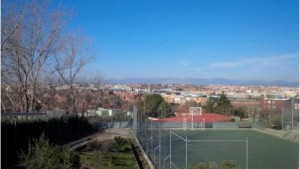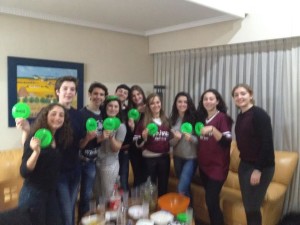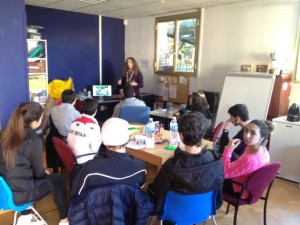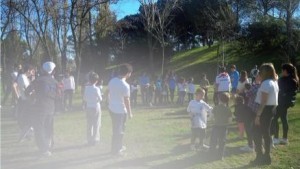SAC Visit to Madrid Experience by Julia Owen
Hello Everyone!
At the end of January I was privileged with the opportunity to travel to Madrid, Spain on behalf of Sephardic Adventure Camp. Why, you ask? The Sephardic Jewish community of Madrid has formed a partnership with our near and dear Seattle Sephardic community, and upon doing so we have decided to explore the possibility of welcoming the youth of Madrid to Sephardic Adventure Camp as both campers and counselors. This past summer we had two counselors from Spain, Rafa Bentolila and Yosef Benzaquen, who enlightened us with their experiences and immersed themselves in our sacred S-A-C community. Fellow staff and campers alike adored our two Spaniards, and we walked away from last summer looking for more. I was privileged to travel to Madrid from January 20th through 25th to spend time getting to know their community, as well as sharing with them information about Sephardic Camp and our community in Seattle as a whole. My experience was life-changing!
There are three synagogues in Madrid, one called Trinquete, one in the downtown area called Bet Yaacov, and one called Sinagoga Rambam in a residential neighborhood called Alcobendas. Sinagoga Rambam shares a property with the Ibn Gabirol Estrella Toledano school, as well as the offices of the two youth movements in Madrid, Yajad and Maccabi Tzair. I stayed in Alcobendas at a nearby hotel so that I could spend as much time as possible interacting with different community members in their respective institutions. On Thursday morning, after meeting Yajad youth department staff including Yocheved Maitlis and Alexis Einhorn, as well as some of the school and synagogue administration including Ethel Barylka and Rose Volf, Ethel, Rose, Alexis and I traveled to the office of David Hatchwell Altaras, the President of the Jewish Community of Madrid. David told me about his previous trips to Seattle, and spoke highly of his experiences there as well how important he believes to be the relationship between the Madrid and Seattle communities. He was enthusiastic about the possibility of sending youth to Sephardic Adventure Camp, and even told me about the Madrid community’s July summer camp, which we could consider sending our youth to as well! I walked away from our meeting feeling that the importance of our camp and our community are well-supported by the leadership of the Jewish Community of Madrid.
View from Ibn Gabirol Estrella Toledano School
After spending time with David, I returned to the Ibn Gabirol Estrella Toledano school, where I ate lunch with a few of the teachers, and was later given a tour of the school by Ethel Barylka, who is not only the Head of Judaic Studies in their school but also the wife of Rabbi Yerahmiel Barylka- the Rabbi of Sinagoga Rambam. The school serves kids as young as one and two years old and as old as twelfth grade. Something about the bright-colored walls, smiling teachers, and welcoming students of all ages reminded me a lot of my experience at both the Seattle Hebrew Academy and the Northwest Yeshiva High School. Along every hallway were things like huge posters of the human anatomy labeled in English, drawings of the Israeli flag or different sites in Israel, as well as colorful paintings with Spanish words in them painted by the pre-schoolers. Teachers and students alike greeted me excitedly, and responded enthusiastically when I told them about Sephardic Adventure Camp and our community in Seattle.
I spent Shabbat with the Maitlis family, who are on their second year of shlichut (Israeli Army Community Service) from Israel to the Alcobendas community, and I had an absolutely amazing time with them and their two awesome kids. Interestingly, services at Sinagoga Rambam start at 7:30 pm on Friday night regardless of the time of year, so we waited for a while after Shabbat began before walking about thirty minutes to the school/synagogue property. I enjoyed Kabbalat Shabbat and Arvit (the Friday night services) greatly, because many of the tunes they used were similar to those that are used for the same prayers at either Ezra Bessaroth or Sephardic Bikur Holim, and if they weren’t tunes used for the same prayers they were either tunes we use for different prayers or variations of tunes we use for different prayers. Needless to say, I walked away from tefilah with a warm feeling in my heart because of the homeyness of the whole thing. Unlike any synagogue I’ve seen before, their synagogue had a kiddush after services for all those that came to tefilah. There were about thirty or forty adults and twenty or so kids, and everyone gathered in the school lunchroom for a light kiddush. Rabbi Barylka had introduced me during his announcements in the sanctuary, so at the kiddush I spoke with a number of parents and kids who were curious about why I was visiting.
Shabbat morning I went to Sinagoga Rambam for Musaf, and was again greeted warmly by not only familiar faces but also familiar tunes. After Musaf, everyone walked together to the lunchroom for a sit-down kiddush/light lunch which had foods like lox and crackers, assorted fruit platters, meat sliders, a variety of nuts, and a few different kinds of cookies. Each week, community members take turns preparing and giving over a D’var Torah during this kiddush, and anyone in the community is invited to do so– men, women, children alike. Although it was in Spanish, I was able to understand some of what the woman who spoke was talking about, and it seemed like she was discussing the importance of each community member’s role in the community, emphasizing that both women and men have integral roles but that they are distinct in their nature. She used Moshe and his sister Miriam, mentioned in that week’s perasha, to illustrate her idea. After she spoke, anyone present was invited to respond or bring up any other ideas or questions, which resulted in a beautiful dialogue between the community members. What I most appreciated about their discussion was that Rabbi Barylka didn’t insert himself into the conversation unless a question was specifically directed towards him. This enabled community members to respond to one another very genuinely and openly, without any fear of being criticized. Once their discussion was done, I spoke for four or five minutes about S.A.C then answered a few of their questions. The rest of Shabbat was very restful, as I went back to the Maitlis’s house after the kiddush and we just hung around there for the afternoon.
When Shabbat was over I met Alexis at the home of a 10th grade girl who was hosting a peula (activity) for any 10th graders involved in Yajad. There were about ten kids there, and after I got to know them a little bit I gave them a presentation about S.A.C., after which they taught me a few different games that they like to play which I will definitely be bring back to Camp this summer! Though we don’t yet know for sure, hopefully a few of these kids will be able to come to Camp!!
Peula with 10th Graders
On Sunday, after speaking to about fifteen 11th and 12th grade Madrichim (counselors) about joining our staff this summer, I watched them in action as they carried out a Tu Bishvat-themed program for over fifty kids in a park nearby. They had art projects, games, trivia questions, and all sorts of other activities that they ran for the kids- all in a huge field area of the park, and under the beaming sun. It made me wish that I could participate in the programs myself!
Meeting with Madrichim
Program Run by Madrichim
In the evening, I returned to the school’s property to join the synagogue’s community for a Tu Bishvat event, which was one of the highlights of my trip. About one hundred adults and kids gathered together at food-covered tables around a projector in the lunchroom, and proceeded to participate in a Tu Bishvat Seder! Members of the community took turns reading the slides which included different information about different foods, and after reciting the beracha on each different food everyone ate that food together. There were also about five different songs that the kids had learned in school which different kids led the community in singing, and overall it seemed like kids and adults of all ages had a fantastic time learning, eating, and celebrating together. What was most interesting to me about their seder was that they included four cups of wine dispersed throughout the evening, each of which symbolized something different. The cups included one that was all white, one that white with a few drops of red, one that was half and half, and one that was all red. Each of these cups symbolized a different season throughout the year, and the final one demonstrated our moving into the beautiful Spring time. Everyone left the event smiling, and I was grateful that I had the opportunity to take part in it.
Overall, my trip to Madrid was fantastic. I was able to spread the word about Sephardic Adventure Camp, and I was also given the opportunity to really get to know their wonderful community. As we continue to prepare for Camp this summer, I am absolutely thrilled that at least two of their madrichim with join us as counselors and that we will hopefully have a few kids from their community as well. Hopefully this is just one of many steps that the Seattle and Madrid communities take to further our relationship and join closer together.
Al Vuermos,
Julia Owen





Thank you Julia for describing your amazing trip to a warm and hospitable community.